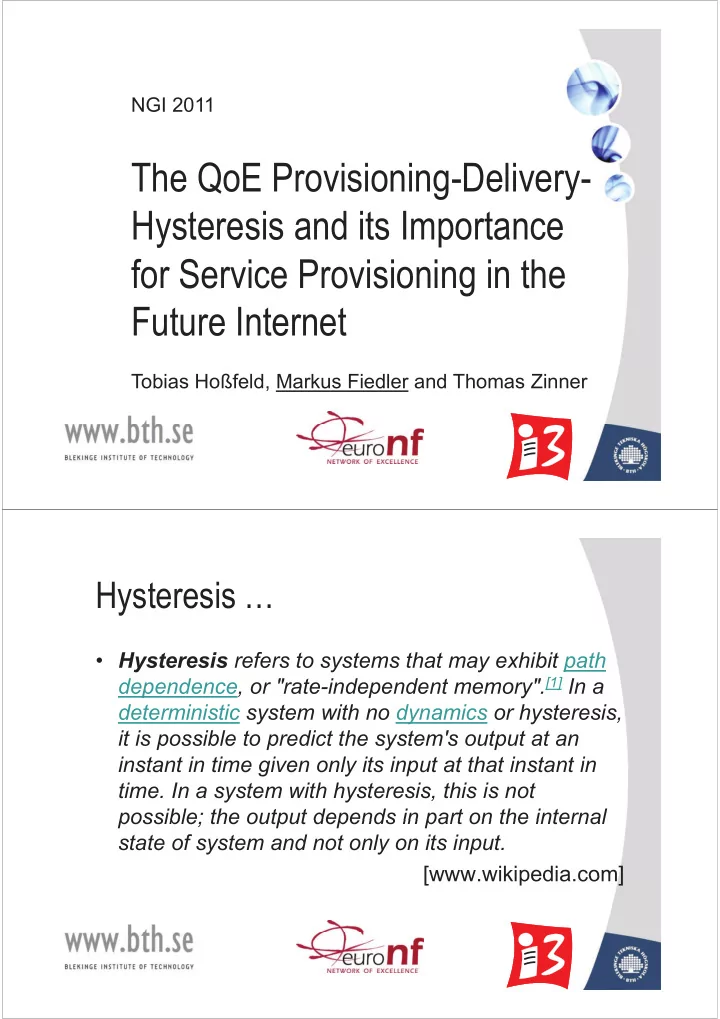

NGI 2011 The QoE Provisioning-Delivery- g y -- Hysteresis and its Importance for Service Provisioning in the F t Future Internet I t t Tobias Hoßfeld, Markus Fiedler and Thomas Zinner Hysteresis Hysteresis … • Hysteresis refers to systems that may exhibit path dependence, or "rate-independent memory". [1] In a deterministic system with no dynamics or hysteresis, d t i i ti t ith d i h t i it is possible to predict the system's output at an instant in time given only its input at that instant in instant in time given only its input at that instant in time. In a system with hysteresis, this is not possible; the output depends in part on the internal possible; the output depends in part on the internal state of system and not only on its input. [www wikipedia com] [www.wikipedia.com]
… and Quality of Experience and Quality of Experience [http://frombogotawithlove.com/wp-content/uploads/2009/10/Bored-Computer-User.jpg] Hysteresis and Quality of Experience Hysteresis and Quality of Experience PDH QoE • Input p • Goodput p • Output • User satisfaction • Internal state • Internal state • To distinguish: • To distinguish: – Provisioning – Delivery problems Delivery problems
Two branches of the hysteresis Two branches of the hysteresis • Up = provisioning – More packets per unit of time QoE – More bandwidth and goodput – Typ. QoE = � + � log ( QoS ) • Down = delivery issues y QoS QoS – Less packets per unit of time – Loss reduces goodput Loss reduces goodput – Typ. QoE = � + � exp( � QoS ) It’s a matter of signs It s a matter of signs … Q S QoS Q E QoE • Satisfaction rating • Resource measure r – The higher, the better – The higher, the better – Mean Opinion Score (1..5) Mean Opinion Score (1 5) – Throughput, goodput Throughput goodput QoS • Success measure s – Availability (e.g. 99.99 %) – Availability (e g 99 99 %) – Packet success ratio Not considered here: QoE QoE • Failure rating • Failure rating QoS • Failure measure f – The higher, the worse – The higher, the worse – Cancellation rate Cancellation rate – Packet loss ratio P k t l ti – Churn rate – Delay jitter – Reordering Reordering
… and a matter of being in control. and a matter of being in control typically on application layer typically due to network impairments The PDH is seen for voice [14] The PDH is seen for voice [14] …
… for live video streaming [21, 23] … for live video streaming [21 23] … and for web surfing [17] and for web surfing [17]
What to do? What to do? Simple rules for preserving reasonable QoE: 1. Avoid trouble – through management 1. Avoid trouble through management – Skype’s approaches • Increase of consumption for voice [10, 12] p [ , ] • Decrease of consumption for video – Communication between providers 2. Save resources in a controlled way – through dimensioning through dimensioning – Gain formulae Skype’s increase of consumption for voice Skype s increase of consumption for voice FEC: x2
Skype’s decrease of consumption for video Skype s decrease of consumption for video Communication between providers (!) Communication between providers (!) • Frameworks available, e.g. FP7 SmoothIT; IETF ALTO; P4P; PaDIS; …
Potential for savings, web example Potential for savings web example Gain curves Gain curves � � � � G � � exp MOS 10 2 3 3 19.9 G � � ln(MOS) 18.3
Lessons to learn for future provisioning Lessons to learn for future provisioning • Better reduce resource consumption – Slightly less quality – Slightly higher response times – Eventually replace some fidelity by redundancy – Cooperation between application and network provider – Reduced energy consumption per user than suffer from problems – Avoid losses, freezes, …, churn Avoid losses, freezes, …, churn – Do not squeeze traffic in an uncontrolled manner Conclusions & future work Conclusions & future work • Design future services, applications, enablers etc. such that users do not suffer unnecessarily – Systematic changes in provisioning keep QoE on an acceptable level – Accidental changes due to problems drag QoE down • Further work required w.r.t. understanding Further work required w r t understanding fundamental relationships between – User-related QoE parameters U l t d Q E t – Technical QoS parameters
Acknowledgements Acknowledgements • To the QoEWeb team – University of Würzburg y g – Orange Labs/France Télécom – Warsaw University of Technology Warsaw University of Technology • QoEWeb was a Specific Joint Research Project from the First Call (2008–2009) Project from the First Call (2008 2009) Thank you very much! Thank you very much! Q & C Q markus fiedler@bth se markus.fiedler@bth.se
Recommend
More recommend